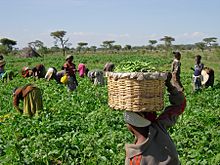- 81 reads

In the past few years, numerous world aid agencies and foundations have pin-pointed the African country Ethiopia as a priority regarding increased efforts to make the agricultural industry more sustainable. The Food and Agriculture Organization of the United Nations (FAO) have made the improvement of Ethiopian agriculture a part of their sustainable development goals (SDGs), and the Bill & Melinda Gates Foundation have philanthropically devoted time and money to the agricultural economy in Ethiopia. Bolstering the Ethiopian agricultural industry is so important because of the repercussions it has on the quality of life, food security, health, stability of economy, and autonomy of the Ethiopian people. Additionally, the rest of the world is affected as well due to international trade and the effects on the climate and environmental health that result from the country’s agricultural processes. One sustainable solution that may prove to be necessary to maintain Ethiopia’s agricultural economy as well as the planet’s health is the use of indoor farming with LED Grow Lights.
A prominent concern that motivates aid organizations is the high levels of malnutrition and low levels of food security among the Ethiopian people. Food security refers to the availability of food and one’s relative access to it, concepts that are lacking in Ethiopia. According to USAID, 2.9 million Ethiopians were displaced from their homes in 2018 due to conflict; coupled with the thousands of refugees Ethiopia hosts, food insecurity is widespread among the population and millions of people starve everyday. Indoor grow farms are a beneficial and sustainable solution that would greatly alleviate hunger and increase food security because they facilitate simple agricultural processes and yield healthy, local-grown food that promotes a farm-to-table nutritional lifestyle. In doing so, indoor grow farms minimize the need to pay for costly imports and food transportation, and instead provide easy access to nourishment with a “grown in your own backyard” concept. Another obstacle to food security with traditional Ethiopian agriculture is the fact that only about 12% of the land is naturally arable and can support conventional farming practices, severely reducing growing potential and crop accessibility. Indoor farming solves this problem because grow farms can be sustained on any type of land, whether it is arable or not, since the farm conditions are artificially maintained to simulate near-perfect growing conditions at all times in any location. Therefore, indoor grow farms can be established on even the most arid land with the harshest climate and still successfully produce healthy, plentiful crops year-round, increasing food availability and accessibility (food security) for the Ethiopian population. More on Benefits of Indoor Grow Farms on Food Security
Another benefit of the agricultural industry in Ethiopia is its potential to provide autonomy to the citizens. However, the rough climate and landscape and the lack of money and government regulation leaves much of this potential untapped and often overlooks the needs of underrepresented populations such as women and children. According to the Gates Foundation, women are vital for driving social and economic growth within their communities, but are often not given decision-making power in the agricultural system. Therefore, by investing in inclusive agricultural technology that
creates a conducive policy environment and invests public resources into modernization of the rural sector (Bill & Melinda Gates Foundation)
women are able to join in on the agricultural efforts of their community and regain autonomy. Technology like the indoor grow farms with LED Grow Lights are an enormous component of agricultural modernization and facilitate close cooperation among communities, providing opportunities for growth and empowerment to women and their communities as a whole.
Food farming and livestock farming are the most important economic industries in Ethiopia. They account for about 46% of GDP and 80% of the country’s exports. Ethiopia heavily relies on a select few farmed products (coffee, animal products, etc) to support their economy, placing themselves in a very precarious situation. Should the yield for these products be unusually low one year due to natural factors such as droughts, floods, disease, etc, the economy would greatly suffer and trade earnings would worsen. For this reason, the country’s current agricultural practices are not sustainable and do not provide a safe quality of life. Indoor grow farms are a great solution for this challenge because they are heavily protected against the unpredictable blights of nature. The soil, temperature, water, and other growing factors are manually controlled and therefore do not easily fall victim to nature’s volatility. The practice of indoor farming allows Ethiopian growers to place increased trust and reliability in agriculture, strengthening the country’s economy and minimizing its risk of crumbling. Regarding, Ethiopia’s livestock industry, studies have shown that the world’s livestock populations are significantly endangered, and with the current trend, will be extinct by about 2026 (referred to as Year Zero). These alarming numbers make it clear that in order to preserve wildlife on the Earth, livestock agriculture must be greatly reduced. Being one of the primary exporters of livestock products, Ethiopia’s already fragile economy takes a major hit from the increase of wildlife conservation efforts. In order to supplement the economy and make up for the profits and GDP lost by reducing livestock agriculture, Ethiopia must increase food production and exports. Since people cannot increase the amount of usable land or control natural factors, increasing conventional farming practices cannot yield nearly enough product to cover the loss from the livestock industry. Indoor farming with LED Grow Lights, however, has proven results indicating its ability to produce high-yield crops year-round that can sustain Ethiopia’s economy. By investing in indoor farming practices, Ethiopia’s economy is rewarded with increased stability, as well as the ability to cut down on livestock agriculture to preserve the planet’s wildlife and reverse the effects of the impending path of environmental destruction and detriment.
To learn more about Wildlife Depletion and “Year Zero” please watch this short video

